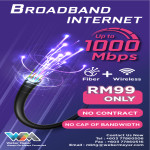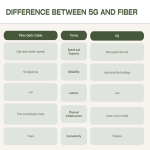Fiber Optic cable vs Ethernet Cable
"**Fiber Optic Cables vs. Ethernet Cables: A Networking Showdown** When it comes to data transmission in networking applications, two heavyweights go head-to-head: fiber optic cables and Ethernet cables. Each employs distinct technologies, offering unique advantages and limitations. Let's dive into the battle of these titans to understand their differences and find out which one reigns supreme for various networking needs. **1. Transmission Technology:** Fiber optic cables utilize pulses of light to transmit data through thin strands of glass or plastic called optical fibers. On the other hand, Ethernet cables, also known as twisted-pair cables, transmit data using electrical signals through copper wires twisted together. **2. Speed and Bandwidth:** Fiber optics flex their muscles in this arena, offering lightning-fast data transfer rates and expansive bandwidth. With speeds ranging from hundreds of megabits per second to several gigabits per second and beyond, fiber optics outpace traditional Ethernet cables. While Ethernet cables have evolved to handle speeds up to 10 Gbps, they still generally lag behind the potential of fiber optics. **3. Distance:** Here, fiber optic cables exhibit their superiority once again. They can transmit data over much longer distances without signal degradation. Single-mode fiber optic cables can span tens of kilometers without the need for signal repeaters. Ethernet cables, on the other hand, have distance limitations, with Cat5e and Cat6 cables handling up to 100 meters before experiencing signal loss. **4. Interference and EMI Immunity:** In the battle against electromagnetic interference (EMI), fiber optic cables emerge as champions. Their use of light signals makes them immune to EMI, making them ideal for environments with high electromagnetic interference. Ethernet cables, especially the unshielded variety, are more susceptible to EMI, leading to potential performance issues in noisy environments. **5. Installation and Flexibility:** Here, Ethernet cables gain an edge. Their installation is simpler, requiring no specialized expertise. These widely-used cables are known for their flexibility and durability compared to fiber optics, which are relatively fragile and require careful handling during installation. **6. Cost:** Finally, in the realm of cost-effectiveness, Ethernet cables have the upper hand. Historically, fiber optic cables have been more expensive due to the technology involved and the cost of specialized components. Ethernet cables, however, remain affordable and accessible, particularly for shorter distances. In conclusion, the choice between fiber optic cables and Ethernet cables depends on the specific requirements of the network and the budget available. For high-speed, long-distance, and interference-prone networking environments, fiber optics reign supreme. On the other hand, Ethernet cables are the go-to solution for most everyday networking needs, offering affordability and ease of installation." (Note: The above excerpt is a generated text and may not represent an actual published article. It is intended to showcase a comparison between fiber optic cables and Ethernet cables for illustrative purposes.)

Layers of Fiber Optic Cables: Ensuring Efficient Data Transmission
Unravel the intricate layers of fiber optic cables, powering the seamless transmission of data. The core, a light-transmitting wonder, is embraced by the cladding, ensuring efficient total internal reflection. Further protection comes from the resilient coating, safeguarding the delicate fibers from external stress. Enhanced durability is provided by the strength members encircling the core. Finally, the rugged jacket shields against environmental elements, enabling reliable data transmission across vast distances.




